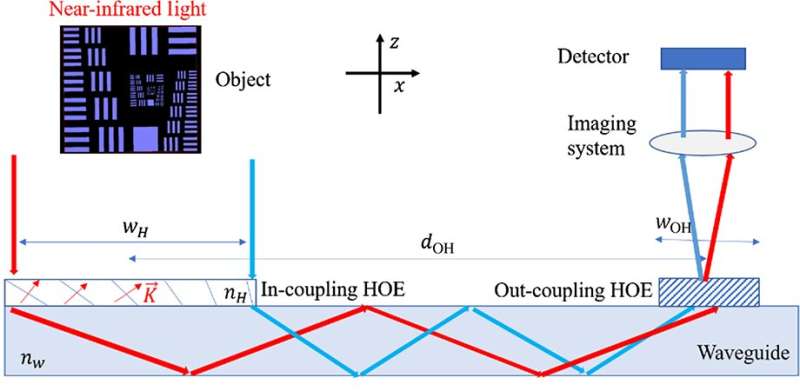The geometrical configuration of a waveguide holographic optical element eye-tracking system. Credit: Jianbo Zhao et al., doi 10.1117/1.OE.60.8.085101.
The eyes have it. They are constantly on the move when viewing scenes in augmented reality (AR).
Now, developers of AR headsets and mixed reality systems have become increasingly interested in the ability to track these eye movements with their eyewear, allowing system designers to improve image fidelity and contrast across the field of view without excessive demands on the power of the projection system. This in turn leads to longer battery life and greater utility of the AR system.
While different eye-tracking systems have been investigated, they are either bulky or have low resolution. Holographic optical elements (HOES) have been shown to be well suited to AR eyewear. They can be fabricated to realize complex optical functions, such as high efficiency, in relatively thin films that can be deposited on either flat or curved surfaces. Two promising materials for HOES/AR eyewear are dichromated gelatin (DCG) and dry-processed Covestro photopolymers. However, the sensing operations in AR systems require near-infrared wavelengths in the 750 to 900-nm range. This exceeds the normal sensitivity range of DCG (350 to 550 nm) and PP materials (450 to 650 nm). It complicates the design of optical elements that have focusing power since significant aberrations result when the reconstruction wavelength differs from the construction wavelength.
In a recent article, researchers from the University of Arizona devised an experimental holographic input coupling lens via a photopolymer deposited on a 0.6-mm-thick glass substrate with a refractive index of 1.80 that corrects major aberrations due to the change in reconstruction wavelength. In addition, an out-coupling waveguide HOE multiplexed with five gratings was designed and fabricated to increase the field of view. The researchers say the result shows the potential of a holographic waveguide eye-tracking system that can be improved upon in future work.
More information: Jianbo Zhao et al, Design of a waveguide eye-tracking system operating in near-infrared with holographic optical elements, Optical Engineering (2021). DOI: 10.1117/1.OE.60.8.085101
Provided by SPIE























